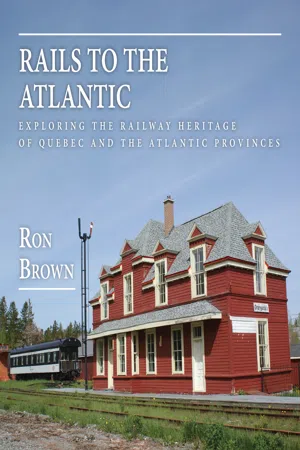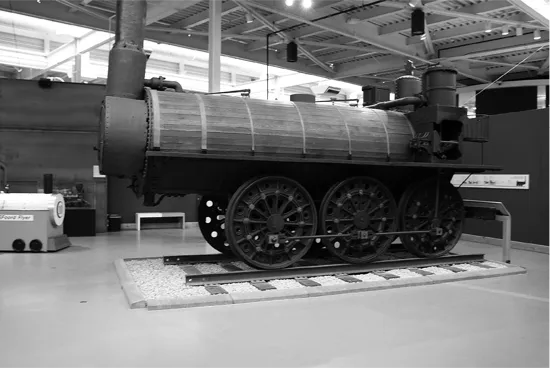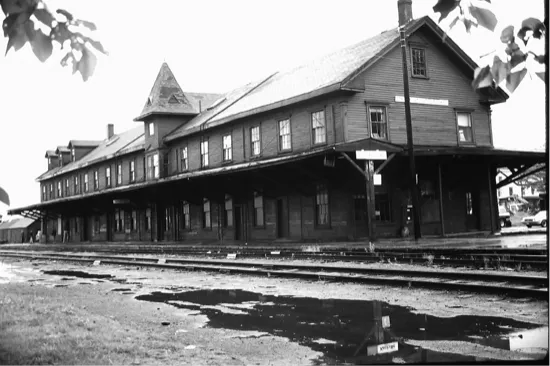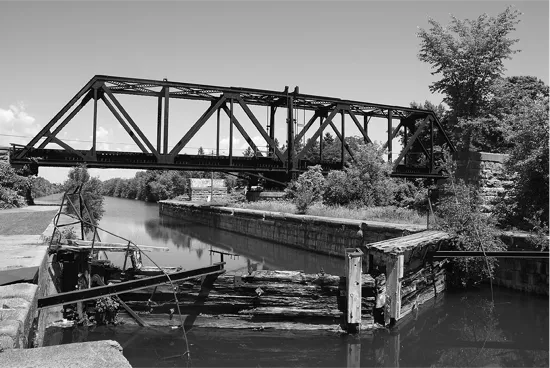While the railway age arrived in Great Britain in the 1820s, a decade would pass before rails made their way to Canada. In 1829 and 1834 horse-drawn tramways began hauling coal from the Canadian towns of New Glasgow and Sydney Mines, respectively. The lines connected the coal mining regions of the interior of Cape Breton to the coast. The Albion Railway began operating steam engines in 1838, two of which, the Samson and the Albion, are on display at the Museum of Industry in Stellarton, Nova Scotia.
In 1836 the country’s first rail line opened between Lac-Saint- Jean and the St. Lawrence River across from Montreal. Using wooden rails with iron strapping, it served mainly as a portage line. The line was about twenty kilometres long and shortened the distance over which goods had to be shipped from New York City to Montreal. In 1851 the line was extended to Rouses Point, and in 1864 it was absorbed into the Grand Trunk Railway (GTR) system. A replica of one of the line’s early steam locomotives, the John Molson, operates at Exporail in Saint-Constant, Quebec.
However, it wasn’t until the 1850s that eastern Canada’s railway age truly began. The GTR was chartered to link Sarnia with Portland, Maine, in 1852. This was accomplished, in part, by absorbing the existing Atlantic and St. Lawrence Railroad, which had opened in 1851 and ran from Montreal to Richmond and south to Portland. Next, the GTR took over the Quebec and Richmond Railway, which linked Richmond to Levis. By 1856 the GTR was finally running trains from Montreal to Sarnia and Portland, as well as to Levis. By 1859 the GTR’s 1,530 kilometres of track made it the world’s longest rail line.
But the line still required a ferry to carry passengers and freight across the St. Lawrence at Montreal. And so the Victoria Tubular Bridge (later renamed the Victoria Jubilee Bridge) was built in 1859 to span a three-kilometre crossing of the St. Lawrence. The bridge was considered an engineering marvel of its day.
But with the GTR running to Portland rather than to Halifax, both Nova Scotia and New Brunswick felt shut off from the rest of British North America, and so turned to rail construction of their own. The New Brunswick and Canada Railway ran up western New Brunswick from St. Andrews to Woodstock (and eventually to Edmunston), while the European and North American Railway forged a link between Saint John, New Brunswick, and the port of Shediac. The Nova Scotia Railway opened between Halifax and Truro with branches to Windsor.
Finally, in 1867, the newly minted Canadian federal government approved the construction of a line to link the beleaguered new provinces. Oddly, since they were no longer colonies, it was called the Intercolonial Railway (ICR). By 1876 the ICR had absorbed the two regional lines and completed a link to Rivière-du-Loup on the south shore of the St. Lawrence where it met with the GTR. The ICR subsequently acquired the GTR from there to Levis, opposite Quebec City. It then took over a branch from Truro and New Glasgow in Nova Scotia to the Strait of Canso, and then became the pre-eminent rail line in the Maritimes.
Canada’s first steam locomotive was the Samson, built for the coal mines of Nova Scotia and now housed in the Nova Scotia Museum of Industry in Stellarton.
Kentville was the centre of the Dominion Atlantic Railway operation in Nova Scotia, with offices housed in this large station.
The Dominion Atlantic Railway (DAR), Nova Scotia’s most iconic rail line, was incorporated in 1895. It had absorbed a number of earlier lines and charters, including the West Counties Railway, the Cornwallis Valley Railway, and the Midland Railway. By the time the CPR took out a ninety-nine-year lease on the railway in 1912, the line could count forty-eight station stops between Windsor Junction and Yarmouth. The Halifax and Southwestern Railway operated on the opposite of the province, running from Halifax along the south coast also to Yarmouth. It fell into the Canadian Northern Railway (CNoR) network in 1915. Both lines are now abandoned and have become rail trails with a handful of stations and bridges still in place.
In the 1870s and 1880s Quebec began encouraging colonization rail lines of the Laurentians, often led by parish priests, to help ease congestion on the overcrowded farmlands of the St. Lawrence Valley. Colonization rail lines were built to connect the region to the rest of Quebec. These lines extended variously to Lac-Saint-Jean, to Labelle (later known as the iconic P’Tit Train du Nord), to Huberdeau, and to Waltham, where the line was known as the Pontiac and Pacific Junction Railway. Another line stretched from Hull to Maniwaki. It is now abandoned, although a small section continued to host steam excursions between Hull and Wakefield. Originally part of the Quebec Montreal Ottawa and Occidental (QMO&O) system, these colonization lines were little more than branch lines, leased by the CPR.
One of New Brunswick’s key railway men was the irrepressible Alexander “Boss” Gibson. He started his empire by creating a townsite around his cotton mills at Marysville, five kilometres from Fredericton on the opposite side of the St. John River. He then put his mind to creating a railway line. Starting in 1872 he began acquiring a number of shorter rail lines, and by 1892 his network encompassed much of western New Brunswick from St. Andrews to Edmunston. In short order it was acquired by the CPR, then expanding its empire eastward.
Meanwhile, the CPR had completed its route to the west coast and was looking to expand eastward. It absorbed the DAR from Windsor Junction (its Halifax link) to Yarmouth, in western Nova Scotia. The CPR also took over the New Brunswick Railway, as well as the QMO&O along the north shore of the St. Lawrence and Ottawa Rivers and on to Ottawa with its branches into the Laurentians. Then, to complete its truly transcontinental link, the CPR acquired the charter of the Atlantic and Northwestern Railway, enabling it to open its Short Line from the west end of Montreal, via Farnham, Sherbrooke, and Lac-Mégantic, through Maine to Saint John, New Brunswick. The charter also called for a bridge over the St. Lawrence River at Lasalle, an impressive feat of engineering that is still used today by Montreal’s AMT commuter service as well as the CPR’s freights. The ICR continued to expand its own network and extended its lines into Cape Breton all the way to Glace Bay, Nova Scotia.
Another addition to the growing network of rail lines was the Quebec Central Railway, which by 1895 had built lines south from Quebec City to Lac-Mégantic, and to the American border at Beebe Junction where it hooked up with the important Boston and Maine Railway.
By 1900 rail lines were everywhere, often duplicating each other. But it wasn’t over yet. Two more ambitious transcontinental routes were still to come.
In 1895 a pair of railway contractors for the CPR decided to strike out on their own. They were William Mackenzie and Donald Mann. Their method was to grab up unused charters and uneconomical lines. Beginning in Manitoba, they extended their way westward to Vancouver and eastward into Ontario, Quebec, and the Maritimes, where they obtained the charter of the Quebec and Lac-Saint-Jean Railway. From a junction at Rivière-à-Pierre on that line they established a line running westerly through Shawinigan Falls, Joliette, and on to the Ontario border at Hawkesbury. They further acquired the Halifax and Southwestern Railway, which ran along the south shore of the province from Halifax to Yarmouth.
The next grand railway plan was that of the GTR and the Canadian government itself. Under the proposed scheme, the government would build and operate a new line that would travel from Moncton through Edmunston, before following the south shore of the St. Lawrence River and crossing into Quebec City over a new cantilever bridge. From there, it would angle northwest, well away from any settled area, through northern Quebec and into northern Ontario. It would then join with the Grand Trunk Pacific (GTP) at Winnipeg. But the GTP was not able to run the entire cross country route and the government took over the entire operation as the National Transcontinental Railway.
In 1871 Prince Edward Island began building a rail line of its own. But it took the involvement of the Canadian Government to finish that line as well, which was used as the catalyst to persuade Prince Edward Island to join confederation in 1875. To help reduce costs, the line was narrow gauge, the rails being only three and a half feet apart. Political pressure forced the line to twist into as many of the scattered communities as possible, resulting in 180 kilometres being built to serve a string of communities only 120 kilometres apart. The line initially ran between Charlottetown, the provincial capital, and Tidnish, the island’s western terminal. By 1910 rails had been extended to Murray Harbour and the eastern terminus of Elmira. In 1915 the PEIR joined the ICR (also known as the Canadian Government Railway), which evolved shortly afterward into the CNR. However, with the arrival of the auto age, passenger service dwindled and in 1968, ended altogether. In 1989 the CNR abandoned the line and removed the tracks. Most of the route today forms the island’s popular Confederation Trail. Dozens of stations survive in a variety of uses.
In 1898 the colony of Newfoundland entered the railway age as well. The idea for a rail line across the rocks of Newfoundland began with Sandford Fleming, Canada’s pre-eminent railway engineer, in 1868. But it took until 1881 for the colonial government to proceed. Construction made it only one hundred kilometres, from St. John’s to Whitbourne, when the builder A.L. Blackman went bankrupt and the government had to take over. In 1893 the government turned building over to Robert G. Reid, who constructed a number of branch lines, and in 1898 finally completed the line across the island to Port aux Basques.
By 1923, however, the Reid family could no longer afford the costs and the government once again took control. Following confederation with Canada in 1949, the Newfoundland Railway came under the Canadian National Railway system, which also operated the ferry links to the mainland. As usual, the beginning of the end of rails on the Rock came with the arrival of improved roads, in particular the completion of the Trans-Canada Highway in 1965. Within four years rail passenger service had ended. Onerous rate increases approved by the CTC (Canadian Transportation Commission) ultimately doomed freight service as well, and in September of 1988 Newfoundland’s last train squealed to a halt in Port aux Basques. As in Prince Edward Island, the Rock was yet another province with no rail service.
Quebec’s mineral resources drew new rail lines in the 1950s, with the CNR adding a loop from Saint-Félicien in the east, northwesterly to Chibougamau, and then on to rejoin the CN line at Barraute west of Senneterre. Independent from Canada’s rail network and its main rail lines, the Quebec North Shore and Labrador Railway, in 1954, extended a 480 kilometre rail line from the port of Sept-Îles on the north shore of the St. Lawrence to haul iron ore from Labrador City and Schefferville. Most of the line continues to operate and offers limited passenger service to this day.
By the 1980s most of the local rail lines were gone. Much of the spider’s web of lines through southern Quebec was abandoned and the rails ripped up. The provincial lines in both Prince Edward Island and Newfoundland were gone by the late 1980s.
When the CNR and the CPR decided that they no longer wished to operate passenger service on the remaining lines, VIA Rail came into existence. But it fared little better, especially in the face of hostile federal governments, both Liberal and Conservative, who discontinued the majority of its early routes. Many of its remaining routes remain underfunded and in jeopardy.
By 2015 much of eastern Canada’s railway legacy was little more than a memory. Stations have been removed and roundhouses razed, leaving little evidence that the rail era even existed. However, thanks to dedicated heritage lovers, what remains of that era is now celebrated through museums, tour trains, and groomed cycling paths on the old rail lines. As well, there remain a number of railway hotels that give tourists and enthusiasts a chance to explore the very towns that the railways themselves brought to life.
( 2 )
Bridging the Gap: The Trestles and Tunnels of Eastern Canada
Think of railway bridges and one immediately conjures the vast chasms and looming mountains that railway structural engineers had to overcome in western Canada’s mountains and the Prairies’ wide valleys. But some of Canada’s longest and most unusual railway bridges span the chasms and canyons of Quebec and the Atlantic provinces.
Railway engineers first built their bridges almost exclusively of wood. It was plentiful, after all, and easy to assemble. But as trains became heavier — and since wood was flammable — the use of iron and steel began to seem like a better idea. In the mid to late 1800s, a number of bridge designers came up with increasingly stronger types of bridge construction.
Truss bridges (a structure whose strength lies in the criss-crossing of lengths of wood, and later iron and steel) can be attributed to William Howe’s railway bridges, built in the United States in the 1840s. Howe worked primarily with wooden structures. Squire Whipple of Utica, New York, created the first iron truss railway bridge in 1846. These gave way to increasingly stronger bridge styles from bridge engineers like James Pratt and Thomas Warren. Terms like deck truss refer to trusses that are situated below the tracks, while a through truss lies above the tracks. An arched or bowstring truss simply refers to a bow shaped top row of steel beams. Piers were initially constructed of stone upon which decks (pre-manufactured sections of track) were placed. Bents refer to the long steel structures that support the tracks used usually in higher trestle bridges. As construction progressed, the preference for steel over iron led to bridges so durable that many remain in use today.
A cantilever bridge’s main support extends from the ends of the structure, rather than resting on piers. They were rare in eastern Canada; however, the cantilever bridge crossing the St. Lawrence River at Quebec City is North America’s longest.
The Bridges of Quebec
Montreal
Because the city sits on a large island in one of the world’s largest rivers, Montreal is surrounded by bridges, among them the world’s greatest feats of engineering.
To the west there lie the two branches of the Ottawa River, which swirl around each side of Île Perrot. As the Grand Trunk Railway (GTR) made its way westward in the 1850s, sturdy bridges to cross these two wide waterways were needed. The bridges at Sainte-Anne-de-Bellevue and the one linking Île Perrot to Vaudreuil were completed in 1854. Designed by the firm Stephenson and Ross, the Peto Brassey Betts and Jordan Company finished the project. The bridges’ sixteen piers incorporated upstream cutwaters to reduce the impact by ice floes.
The Canada Atlantic Railway erected a major bridge over the St. Lawrence River east of Montreal, a portion of which crosses the ruins of a Lachine Canal lock.
The GTR initially built a tubular structure on these bridges — making them, in effect, an enclosed tunnel. That, however, proved unfeasible for a number of reasons: the bridges could not be widened to accommodate planned double tracking, the sides often caught strong gusts of wind, and the long enclosed tubes trapped smoke, making life unbearable for passengers. Finally, in 1898, the tube was replaced with an open steel deck on a row of stone piers.
Mere metres away from the GTR bridge stands the CPR bridge that was built for its main line in the 1880s. The CPR bridge uses a different style — four arched through trusses made of steel on top of a row of stone piers. These historic bridges are best viewed from the Sainte-Anne-de-Bellevue Canal National Historic Site in Sainte-Anne-de-Bellevue, over which both bridges cross.
In 1887 the CPR kept on building, adding its Short Line, from Montreal to Saint John, New Brunswick, to access the year-round port facilities. It crossed the St. Lawrence with its Lasalle Bridge. The first bridge built was a combined truss and box span. In 1908 that bridge was replaced in order to accommodate double tracking. Today’s bridge uses steel deck girders and deck trusses supported on stone piers. A lift bridge over the St. Lawrence Seaway on the south shore lifts the bridge to allow the massive ocean freighters to glide by below. A small fading wooden plaque on Boulevard Lasalle in Parc Saint-Ange near the Lasalle commuter station describes the heritage of the site.
A short di...



